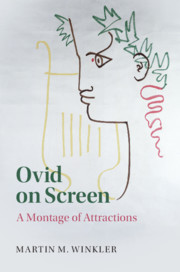Book contents
- Ovid on Screen
- Ovid on Screen
- Copyright page
- Dedication
- Contents
- Illustrations
- Acknowledgments
- D M
- Adages
- Fade-In: Prooemium
- Part I Theory and Practice
- Part II Key Moments in Ovidian Film History
- Chapter 3 D’Annunzio’s Ovid and the Cinematic Impulse
- Chapter 4 The Labyrinth: Narrative Complexity, Deadly Mazes, and Ovid’s Modernity
- Part III Into New Bodies
- Part IV Love, Seduction, Death
- Part V Eternal Returns
- Sphragis: End Credits
- Bibliography
- Passages of Ovid’s Works
- General Index
- Plate Section (PDF Only)
Chapter 4 - The Labyrinth: Narrative Complexity, Deadly Mazes, and Ovid’s Modernity
from Part II - Key Moments in Ovidian Film History
Published online by Cambridge University Press: 27 January 2020
- Ovid on Screen
- Ovid on Screen
- Copyright page
- Dedication
- Contents
- Illustrations
- Acknowledgments
- D M
- Adages
- Fade-In: Prooemium
- Part I Theory and Practice
- Part II Key Moments in Ovidian Film History
- Chapter 3 D’Annunzio’s Ovid and the Cinematic Impulse
- Chapter 4 The Labyrinth: Narrative Complexity, Deadly Mazes, and Ovid’s Modernity
- Part III Into New Bodies
- Part IV Love, Seduction, Death
- Part V Eternal Returns
- Sphragis: End Credits
- Bibliography
- Passages of Ovid’s Works
- General Index
- Plate Section (PDF Only)
Summary
The description of Daedalus’ labyrinth, built as prison without possibility of escape for the Minotaur, is one of Ovid’s most famous passages. Modern, and especially postmodern, theory has often regarded the labyrinth as an analogy to complex literary compositions, with Ariadne’s thread as a kind of reader’s guide through such textual mazes. (Scholars regard Daedalus as a creative analogy to Ovid himself.) Chapter 4 accordingly centers on literal and figurative screen labyrinths. Since around 1960, elusive nonlinear plots became prominent in cinematic narratives, especially in French New Wave cinema. One film is of primary importance in this regard. Last Year at Marienbad, directed by Alain Resnais from a script by novelist Alain Robbe-Grillet, is set in and around an intricate maze-like building, in which time and place seem to exert a hallucinatory effect on the film’s characters and, in equal measure, on its viewers. Fascinating labyrinths appear in various film genres as well. Stanley Kubrick’s The Shining features one literal and one figurative maze; the latter, a large and complex building that exerts a demonic will, is the more deadly one. The titular house of Harry Kümel’s cult favorite Malpertuis is even more hellish – literally so because of its connection with classical Underworld mythology. Briefer discussions of two stylish mysteries, Mario Bava’s The Girl Who Knew Too Much and Jean-Jacques Annaud’s The Name of the Rose, lead to a final section with appreciations of other screen labyrinths and Minotaurs.
Keywords
- Type
- Chapter
- Information
- Ovid on ScreenA Montage of Attractions, pp. 119 - 158Publisher: Cambridge University PressPrint publication year: 2020

